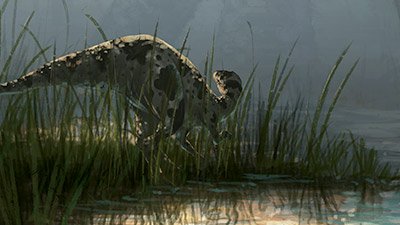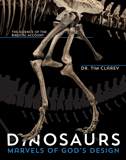
Brontosaurus: The Only Dino to Go Extinct Twice
If you’ve seen any of the Land Before Time or Jurassic Park films,1 you’re familiar with the general appearance of the Brontosaurus. It’s the long-necked, elephant-bodied, lizard-tailed, leaf-eating dino that grazed in green valleys, living peaceably with other animals and, we would add, humans.
Brontosaurus is a genus of the sauropod family Diplodocidae with similar shape and form, in particular, to another diplodocid, Apatosaurus. So similar, in fact, that the Brontosaurus has caused quite a bit of confusion.
The first Brontosaurus was unearthed by famous paleontologist Othniel Charles Marsh in 1879 in the Morrison Formation rocks in Como Bluff, Wyoming. He called the new dinosaur Brontosaurus excelsus, meaning “thunder lizard.”
But Marsh and other paleontologists never found the head of the new dinosaur, and over two decades later, another paleontologist Elmer Riggs declared that the specimen wasn’t different enough from the Apatosaurus, a dinosaur Marsh had discovered in 1877. Riggs changed Brontosaurus excelsus to Apatosaurus excelsus and declared that, while Apatosaurus would be the preferred name, Brontosaurus was a synonym.
But newer research lead by Emanuel Tschopp in 2015 suggests that the Brontosaurus is truly its own genus.2 Tschopp’s research team compared digital, high-resolution scans of every diplodocid bone ever recorded. The team found that there were enough subtle differences in the bones of the Apatosaurus and Brontosaurus to classify them as separate genera, though not all scientists are on board with this. How do creation scientists view the two? In his book on dinosaurs, Dr. Timothy Clarey said, “The differences between the two are really quite trivial. They are merely an example of the diversity God built into the animal kinds.”3 Such minor classification differences, particularly at the genus and species levels, pose no problem in a biblical framework for explaining the wide diversity of animals.
Thus, the Brontosaurus is back from a second extinction.4
Was This Bad Science?
No, it isn’t, and we can still trust the scientific process. Scientists are always evaluating and reevaluating and researching, and new discoveries often lead to new understandings of past discoveries. Scientists are gatherers of knowledge who then share their learning with the world. The word science itself means “knowledge”! But sometimes scientists make honest mistakes—they’re human, after all. And since they’re human, they are limited to speaking authoritatively only on what they can observe, not on unrepeatable, historical events of the past. For historical accuracy, we need a good eyewitness account from a source that can be trusted and has proven to be accurate. The only document with that kind of track record is the Bible.
Found out more about why you can trust the Bible in our Bible Answers section.
Footnotes
- Note that these films purport a millions-of-years history based on evolution.
- E. Tschopp, O. Mateus, and R. B. J. Benson, “A Specimen-level Phylogenetic Analysis and Taxonomic Revision of Diplodocidae (Dinosauria, Sauropoda) PeerJ 3 (2015): e857, doi:10.7717/peerj.857.
- Timothy L. Clarey, Dinosaurs: Marvels of God’s Design, Green Forest (AR: Master Books, 2015), 91.
- Marsh’s Brontosaurus specimen still stands on display in the Great Hall of Yale's Peabody Museum of Natural History.
Recommended Resources

Answers in Genesis is an apologetics ministry, dedicated to helping Christians defend their faith and proclaim the good news of Jesus Christ.
- Customer Service 800.778.3390
- © 2024 Answers in Genesis





